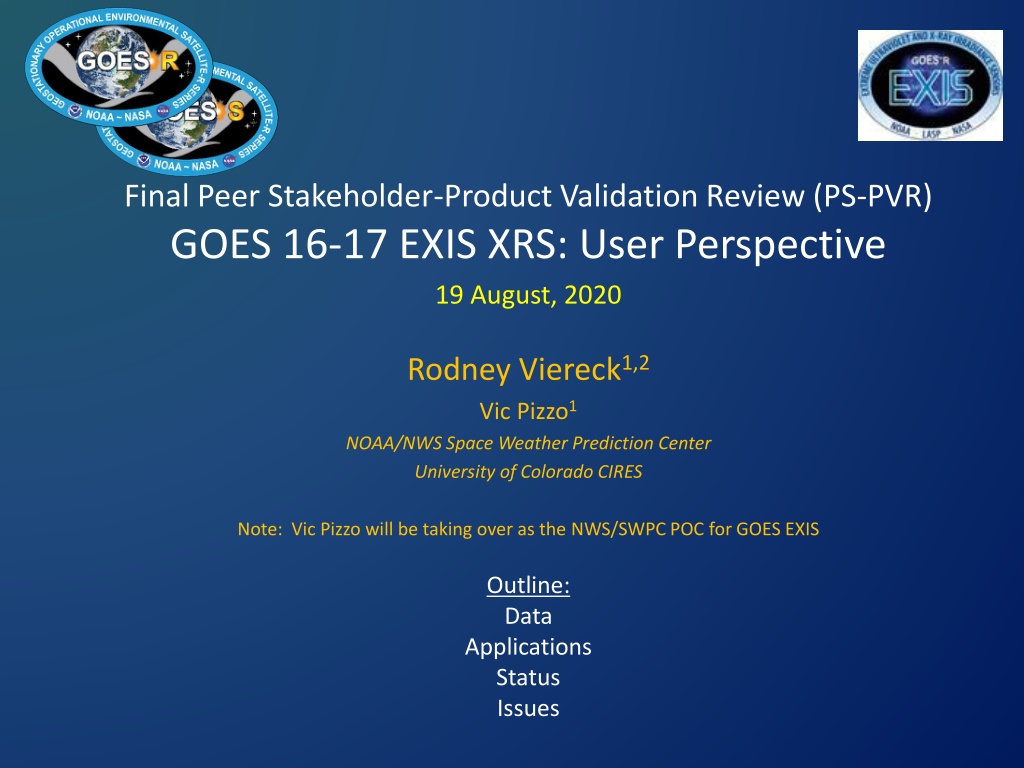Review of GOES 16-17 X-Ray Sensor Data and Applications
Peer Stakeholder Product Validation Review of the GOES 16-17 X-Ray Sensor (XRS) focusing on solar X-ray monitoring for space weather prediction. The XRS monitors solar flares, impacts on space weather events, data applications, alert levels, status, and issues such as data latency and electron contamination during minor flares.
Download Presentation

Please find below an Image/Link to download the presentation.
The content on the website is provided AS IS for your information and personal use only. It may not be sold, licensed, or shared on other websites without obtaining consent from the author.If you encounter any issues during the download, it is possible that the publisher has removed the file from their server.
You are allowed to download the files provided on this website for personal or commercial use, subject to the condition that they are used lawfully. All files are the property of their respective owners.
The content on the website is provided AS IS for your information and personal use only. It may not be sold, licensed, or shared on other websites without obtaining consent from the author.
E N D
Presentation Transcript
Final Peer Stakeholder-Product Validation Review (PS-PVR) GOES 16-17 EXIS XRS: User Perspective 19 August, 2020 Rodney Viereck1,2 Vic Pizzo1 NOAA/NWS Space Weather Prediction Center University of Colorado CIRES Note: Vic Pizzo will be taking over as the NWS/SWPC POC for GOES EXIS Outline: Data Applications Status Issues
Solar X-Ray Sensor (XRS) Monitor the disk-integrated solar flux in two x-ray wavelengths XRSA 0.05 nm 0.4 nm XRSB 0.1 nm 0.8 nm Define the magnitude of solar x-ray flares Solar X-Rays: Change by several orders of magnitude in just a few minutes Are the harbingers of impending space weather storms Are absorbed in the lower ionosphere where the flare enhanced ionosphere blocks HF communication Solar X-Ray Spectrum Solar Flares X Flare Classification M C Daily Eclipses B Day of September 2017 2020-08-19 GOES 16-17 XRS Final PS-PVR 2
Primary Applications of the XRS First notice of major space weather event Most major space weather events start with a large solar flare Establish first look at the size and geo-effectiveness of an event The magnitude of subsequent major space weather (e.g. solar proton events and geomagnetic storms) correlate with the size and location of the flare. GOES XRS is input to Space Weather Models D-Region Absorption (HF Radio Blackouts) Proton Prediction (Radiation Storms) The XRS data drive one of the three NOAA Space Weather Scales R-Scale or Radio Blackouts - driven GOES solar x-rays S-Scale or Solar Radiation Storm driven by GOES solar protons G-Scale or Geomagnetic Storm driven by USGS ground magnetometers D-Region Absorption Model Shows the location and intensity of radio blackouts 2020-08-19 GOES 16-17 XRS Final PS-PVR 3
XRS Alert Levels NOAA R-Scale Alert Levels: M5, X1, X10, X20 Based on customer impacts GOES XRS 2020-08-19 GOES 16-17 XRS Final PS-PVR 4
GOES 16-17 XRS Status GOES 16 XRS is now the primary XRS sensor for operations NASA SDO EVE Sensor is providing secondary XRS-like proxy data Currently working to bring GOES 17 XRS on line via development data stream before the fall eclipse period. GOES 17 should be fully operational in spring of 2021. 2020-08-19 GOES 16-17 XRS Final PS-PVR 5
GOES 16-17 XRS Issues Increased data latency The high-resolution, 1 second data have latency of more than 30 sec due to data aggregation at the GRB terminal. Impact: moderate Electron Correction During Minor Flare Electron contamination The electron contamination is considerable during periods of high electron flux but only affect lower XRS flux values. Impact: minor if corrected. Proton contamination The proton contamination is considerable during periods of high proton flux which are relatively rare. Impact: minor if corrected Note that electron contamination only impacts the lowest values Improved process to monitor and maintain sensor calibration and performance should result in better data quality however, the added complexity has led to delays in getting the proper background levels set and the best electron contamination parameters into operations. requires long-term commitment for support throughout the mission. Excessive time required to prepare the operational data stream. GOES 16 L2 data was not operational until late 2019 Currently waiting on NWS to implement GOES 17 2020-08-19 GOES 16-17 XRS Final PS-PVR 6
Delays in getting GOES 17 XRS data on line GOES 17 L2 data were available for review in Late 2019 SWPC performed and completed a full validation of the GOES-17 data in January 2020. Contracting issues within the NWS Office of Observations, along with extensive delays in the Integrated Dissemination Program (IDP) implementation schedule have delayed the availability of the realtime data stream. SWPC will not have GOES-17 data operationally available to it until Spring 2021. SWPC is working with the NWS Office of Observations to get a GOES -17 development data feed. To support operations during the fall eclipse season To provide redundancy if there is an outage of GOES-16 data feed and products. 2020-08-19 GOES 16-17 XRS Final PS-PVR 7
Summary GOES 16 and 17 XRS data meet the requirements for space weather operations. GOES 16 XRS is the primary (and only) XRS in operations GOES 17 XRS data may become available on a development stream before the upcoming eclipse period (early September) GOES 17 XRS will become operational in the spring of 2021 2020-08-19 GOES 16-17 XRS Final PS-PVR 8


























